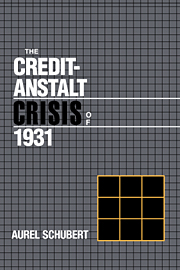Book contents
- Frontmatter
- Contents
- Tables
- Preface
- The Credit-Anstalt Crisis of 1931
- 1 Introduction
- 2 Diary of the crisis
- 3 Financial crisis theories and the Austrian experience of 1931
- 4 The causes of the financial crisis
- 5 The financial crisis and market efficiency
- 6 The financial crisis and economic activity
- 7 The financial crisis and the lender of last resort
- 8 Alternative policies and policy implications
- 9 Conclusions
- Bibliography
- Index
4 - The causes of the financial crisis
Published online by Cambridge University Press: 20 March 2010
- Frontmatter
- Contents
- Tables
- Preface
- The Credit-Anstalt Crisis of 1931
- 1 Introduction
- 2 Diary of the crisis
- 3 Financial crisis theories and the Austrian experience of 1931
- 4 The causes of the financial crisis
- 5 The financial crisis and market efficiency
- 6 The financial crisis and economic activity
- 7 The financial crisis and the lender of last resort
- 8 Alternative policies and policy implications
- 9 Conclusions
- Bibliography
- Index
Summary
Autopsies are valuable in so far as they are scientifically conducted to the end that the knowledge gained is made useful in the future.
–Th. F. Woodlock, Barron's, February 16, 1931If we want to identify the main causes of the financial crisis in Austria in 1931, we have to distinguish among the following: (1) the causes of the Credit-Anstalt crisis; (2) the causes of the banking crisis; and (3) the causes of the currency crisis. Obviously, many of the causes will be shared, since the three different crisis were interdependent.
The causes of the Credit-Anstalt crisis
The causes of the problems of this bank have been discussed quite frequently in the literature. Nevertheless, as März points out, “the definite story of the collapse of the Creditanstalt has not yet been written” (1982, 191). Much of our knowledge goes back to Rutkowski's excellent treatment, and insight into the microeconomic data of the bank would be required to tell the “definite story” and to be able to attach relative weights to the different contributing factors that have already been identified.
Despite the lack of publicly available microdata, we can make inferences from a variety of direct and indirect sources. For one, the losses of the bank will give us insight into the causes of the problems. A comparison to the developments at other, nonfailed, Viennese banking institutions allows us to isolate the CA specific causes.
- Type
- Chapter
- Information
- The Credit-Anstalt Crisis of 1931 , pp. 31 - 64Publisher: Cambridge University PressPrint publication year: 1992



